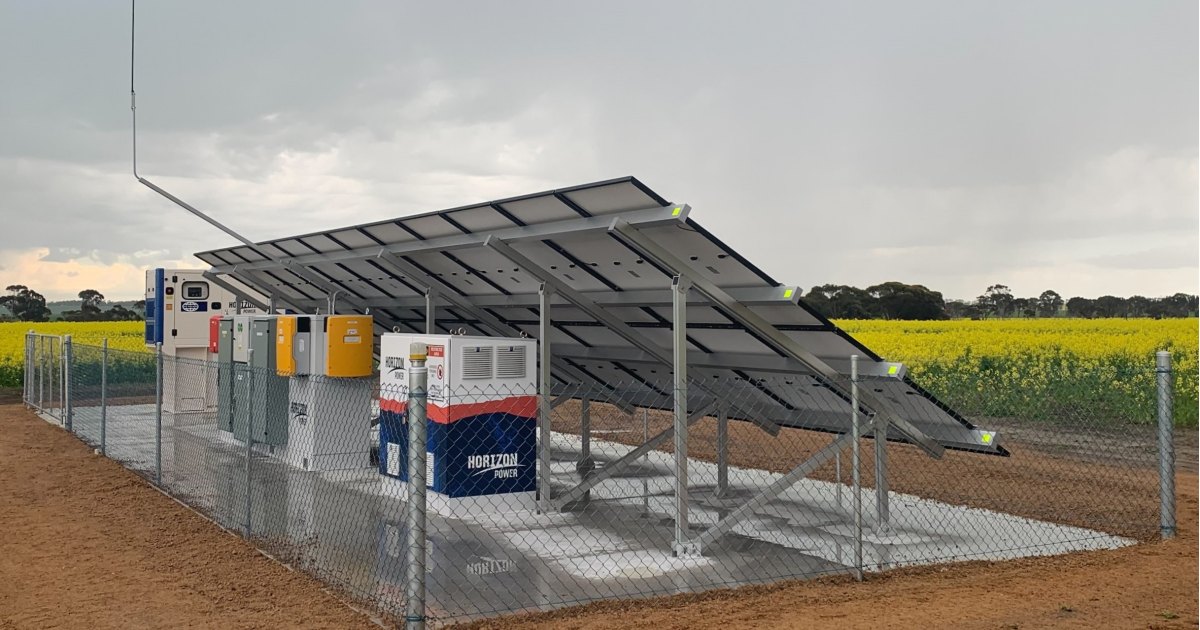
The first solar panel based standalone power system (SPS) installations in WA’s Esperance region under a McGowan Government initiative have been completed, with a bunch more on the way.
An SPS operates independently from the mains grid, providing renewable energy (for the most part) using solar panels and battery storage. A backup diesel generator is also included for situations where the panels can’t supply the electricity required.
A $10 million SPS rollout in the Esperance region, funded by the McGowan Government’s WA Recovery Plan, is being carried out by Horizon Power and its joint venture partner Boundary Power.
Nineteen SPS units have been completed according to WA Energy Minister Bill Johnston, with another 26 to be operational by March this year. The 45 systems won’t just provide beneficiary fringe-of-grid customers with more reliable power, it will also mean 120 kilometres of poles and wires can removed from private property; reducing maintenance and fire risk as well as removing obstructions to farming activities. An added plus is improved safety for workers as the need for rural line patrols, often conducted in dangerous weather conditions, will be reduced.
Another major benefit – various pilots in WA have demonstrated SPS use can be cheaper than maintaining mains grid infrastructure in fringe-of-grid areas. So, as network assets fall due for replacement, it can make economic sense to ditch the poles and wires approach for SPS.
There’s no set size for each system – each property is assessed before customising an SPS to suit the needs of the occupants. These off-grid systems are fully automated and remotely monitored and controlled, with maintenance conducted by local crews.
Previous SPS deployments in Horizon Power’s service area in regional and remote Western Australia have proved to be successful, reducing unplanned outages from several days per year to less than 30 minutes per year. There’s also a significant carbon reduction associated with SPS use, with current estimations indicating this initiative will deliver savings of nearly 129 tonnes of CO2-e per annum compared to a traditional network solution.
Western Power’s Big SPS Rollout
Elsewhere in WA, a rollout of 98 more stand-alone power systems in Western Power’s service area started last year and as far as I know is expected to be completed this financial year.
While Horizon Power’s network is spread over a much larger area, the South West Interconnected System (SWIS) serves the majority of Western Australia’s population – from Kalbarri in the north to Kalgoorlie in the east and Albany in the south. Most of Western Power’s customers are in the Perth metropolitan region, but there are also plenty of fringe-of-grid customers in its service area.
Western Power had previously run similarly successful SPS trials, with customer satisfaction less than six out of ten pre-trial rising to over nine with SPS units in place.
Beyond this current rollout, Western Power’s modelling predicts more than 6,000 SPS units will be deployed over the coming decades across the Mid-West, Wheatbelt, South-West and Great Southern regions of WA.
There would probably be quite a few Western Australians in the SWIS region envious of those with or soon to get SPS units, particularly after around 20,000 families and businesses lost power for more than 12 hours during the Christmas Eve to Boxing Day blackouts. And earlier in December, around 18,000 homes in the Perth metro area were plunged into darkness (and stifling heat) due to debris and bird strikes on infrastructure.
Minister Johnston said last week an independent review into what happened during the long weekend power outages will kick off in the coming months.

 RSS - Posts
RSS - Posts



Where can I find information on the number of homes/kws a SAPS can serve and costings. I live in Scotts Head on the mid-north coast of NSW and there are many stand alone roof top solar systems: I have a 6.5kws with a Frontios Inverter and Eveready Battery. Even on overcast days the battery is 100% (that’s in November and December.
There are a significant number of community members interested in developing solar for our community’s benefit.
Regards
Anthony Bennett
The cost will depend on the size of the system and what it is expected to do. For example, a solar powered water pump that only has to operate in the day is far simpler and cheaper than taking a group of houses off-grid with a microgrid. If you have a specific application in mind you can contact a solar installer who specializes in off-grid installations and see if they can offer a quote. It’s generally going to be fairly expensive compared to staying on grid in an area were the grid electricity is generally reliable.
thanks for that, I will follow up